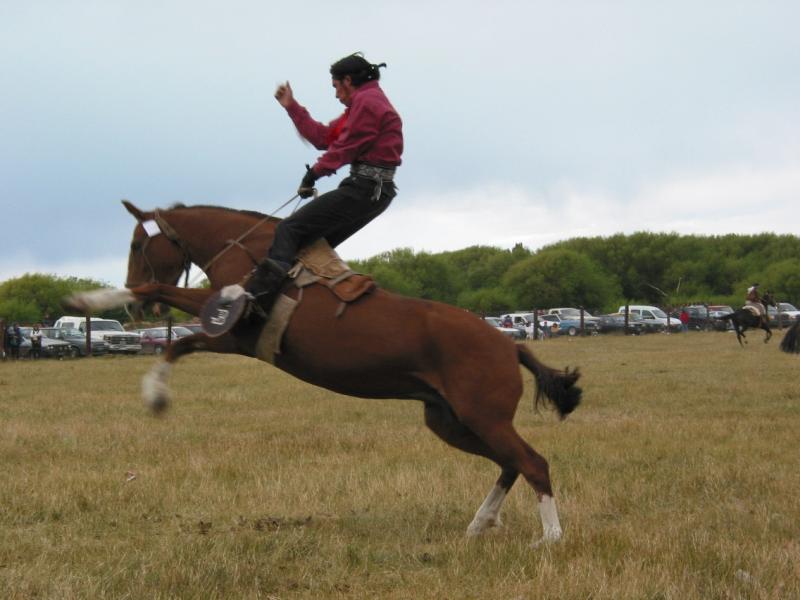[Photo: the gaucho's facón or knife]
Gaucho Photo Gallery
Gauchos have been renowned horse breakers since we have written records about them. The domador or gaucho bronco buster held and continue to hold very high prestige among his peers. As you can read in Gauchos and the Vanishing Frontier, gaucho horse breaking could be very damaging, even fatal, to the horse. "All gauchos could ride reasonably well. A highly skilled horseman would work as a domador or bronc buster. A domador could tame any wild horse to the saddle. As long as wild horses remained plentiful, the domador worked with brutal efficiency. Horses often suffered injury or death. The demand for his special skills earned the bronco buster premium rural wages. By the late nineteenth century wild horses became scarce and mounts became more costly. Harsh, traditional criollo taming methods gave way to gentler ones." [from "Gaucho" in The Cowboy Encyclopedia.]
Given their work of killing cattle, it's not surprising that a facón or large knife accompanied each gaucho. The gaucho carried the knife stuck through the back of his tirador, a wide leather belt. He used his knife to kill and skin cattle, to eat beef, and sometimes to fight an enemy. Over time, the knife became stylized and docorated, such as the gold and silver one pictured here. "The gaucho borrowed freely from Indians of the pampa. He usually wore a poncho over a chiripá (baggy, diaper-like pants). Both garments came from South American Indians. A stout leather belt (tirador) held up his pants. Soft boots made from the leg skins of a colt (botas de potro) and dangling iron spurs covered his feet. He armed himself with the bolas (or boleadoras), a dangerous weapon developed by Indians. A long, swordlike knife (facón) was secured through the back of a rider's leather belt so it would not kill a gaucho who accidentally pitched forward off his horse." (from "Gaucho" in Richard W. Slatta The Cowboy Encyclopedia 1994, 1997.)
As the 20th century dawned, gauchos found themselves economically and socially margianlized. Writer John H. White painted an unhappy portrait of the transition from gaucho to docile ranch peon in Argentina (1942): "The last gaucho has galloped across the far-away horizon of the pampas and into the twilight of history, and Argentina has lost its most characteristic and attractive citizen. His successor is a poor, miserable, underpaid peon who is called a paisano [countryman] but never a gaucho." The gaucho had passed from the realm of history into folklore. Argentine artist Florencio Molina Campos (1891-1959) created entertaining gaucho caricatures from the 1920s through the 1940s. While cartoon-like, his paintings accurately, humorously, and lovingly portray many aspects of gaucho.You'll find more examples of his work at this online gallery of gaucho paintings by Molina Campos. (Click on the titles highlighted in yellow in the righthand column to see the paintings.) Gauchos also found themselves pressed into service as political symbols, for better or worse. Like "cowboy" in the US, gaucho could be either a compliment or a curse, depending on the use.
